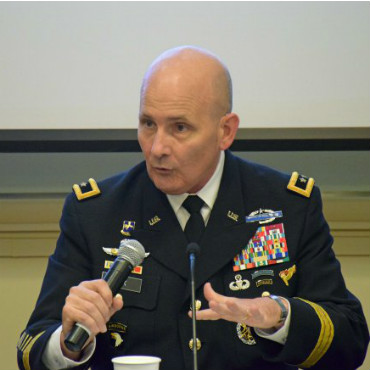Army modernization command looks to avoid red tape

The Futures and Modernization Command, which is set to stand up in 2018, will have to resist the ways of old if it wants to be successful.

Maj. Gen. William Hix, shown here at a 2015 conference, says the Army's new modernization command has to avoid heavy bureaucracy.
The Army is used to getting beat up for being slow to modernize. But in order for the new Futures and Modernization Command to be successful, it can't get bogged down in the Defense Department's traditional bureaucratic ways, says one military leader involved with the program.
"The big thing we seek to avoid [in building the new command] is becoming a bureaucracy that eats a bureaucracy...We're very conscious of that," Maj. Gen William Hix said during a panel on Army futures study at an Atlantic Council event Wednesday.
The Modernization Command was announced in October at the Association of the U.S. Army's Annual Meeting and Exposition, and is set to stand up in 2018. Then-acting Secretary of the Army Ryan McCarthy explained that the service was reaching the limit on what could be accomplished by upgrading existing platforms like the Apache helicopter or the Bradley tank.
"To prevail in the future, we now must reform how we modernize the Army," McCarthy said at the time. "The roles, responsibilities, structures, and organizations we have to address this challenge are disparate and in many respects, born of a bygone era."
Hix, who described himself as a minister without a portfolio, is helping shape and structure what will become the Futures and Modernization Command, and is running headlong into some of the roadblocks McCarthy described in October. For example, Hix noted that some of the laws and regulations on defense management are woefully out of date.
"We're in a completely different technology space today than we were in the 80s. Then, the information age was kind of on the horizon but now it's upon us," Hix said. "We're not saying how are we going to necessarily execute the current system better, we are working at that, but we're also working at what do we have to do to change the system to be more agile and responsive."
Hix said the Army realizes that change is necessary, but that DOD's conservative culture is naturally resistant to change and could stall progress.
"We recognize that we have to maintain the capabilities we have and make sure they're relevant to the problems of today but at the same time we have to be working on the future and the two don't necessarily have to threaten each other and that's called leadership," he said. "And you see [Army Chief of Staff] Gen. Mark Milley, Army Secretary Mark Esper have been very clear on making that happen. And I think you'll see the Army moving in the right direction."
That direction could shake things up for existing commands.
When asked how the reorganization of modernization functions under the new command and away from established organizations such as the U.S. Army Materiel Command and Training and Doctrine Command could impact sustainment and training efforts, Hix said there largely won't be a change except with Program Executive Offices.
"The key for us is linking those folks together under a unified concept and idea without the friction of being under different commands with a different set of incentives and priorities which sometimes causes you to be disjointed," Hix said of the Materiel Command components. "[We're] trying to unify those activities without trying to break those connections they have to the functions that they serve."
But he didn't have an answer for how the reorganization would affect the Army's Program Executive Offices, which sit under the Assistant Secretary of the Army, Acquisition, Logistics and Technology. At minimum, he said the relationship the PEOs have with program managers would change but "the legal authority, the responsibility of the Army acquisition executive is not going change."
Hix also said the Army was looking at other services' models, namely the Air Force and Navy, to influence the command's final design.
"Each service does it differently...I'm not saying we're going to do it like the Navy, I'm not saying we're going to do the status quo or do it like the Air Force but we're going to take the best practices," he said. There's some space for improvement on how we do things in the acquisition community."






